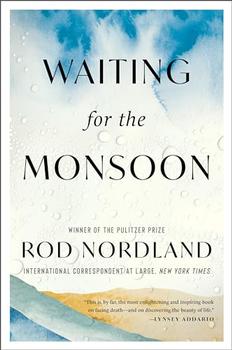Summary | Excerpt | Reviews | Beyond the Book | Readalikes | Genres & Themes | Author Bio

My Second Life
The following article was written from my bed in the Weill Cornell Medical Center's neurology ICU and published on a full page of the Sunday edition of the New York Times.
I routinely give titles to my journals, in which I have long recorded interviews, appointments, odd thoughts, and cris de coeur. My journal commencing June 17, 2019, is called "Waiting for the Monsoon."
The Indian summer has always fascinated me, and I was in New Delhi, experiencing its climatic extremes firsthand.
Summer is when the heat of the subcontinent's vast plains generates an enormous mass of warm air that pushes against the impenetrable massif of the Himalayas to the north, while the west wind drives clouds from the broiling Arabian Sea across the country.
Heat builds to inhuman levels: days of 125 degrees Fahrenheit are not unheard-of; 110-degree days, or 43 Celsius, are common, with humidity sometimes approaching 100 percent.
These are the forces that breed the southwest monsoon, the greatest accumulation of fresh water in the atmosphere anywhere on the planet, and it broods over a landmass with the earth's densest population: 1.3 billion people. The poorest of that multitude suffer grievously from heat and thirst, but all are waiting for the monsoon to bring relief.
For weeks in June and July, black clouds gather as the entire country obsessively tracks the progress of the rains.
The waiting is a time of expectation and worry: if it rains 10 percent more than normal, it means catastrophic flooding; 10 percent less may mean drought and famine.
The high drama of the wait was captured by the fifth-century Indian poet Kalidasa:
Then one day comes "the bursting": all that fresh water breaks as if from a celestial womb, gushing as much as 40 inches in a few weeks.
When the universal longing is finally requited, there is a sense of nationwide relief, bringing with it an almost immediate respite from the terrible heat. Temperatures drop overnight by an astonishing 20 to 30 degrees.
On the morning of July 4, I left Delhi for Uttar Pradesh to report a story on India's feverish toilet-building campaign. I was out on the street most of the day when I noticed ink in my journal was smudged with raindrops. "The monsoon has arrived," I noted.
The smudged page also contained a fragment of overheard conversation: "We will marry our daughter to you only if you have a foot." It was the first line of an intriguing story I would never write ...
The next day I went for a morning jog in Delhi's beautiful Lodhi Gardens. [It was 120 degrees Fahrenheit at 10 a.m.]
That is really the last thing I remember with certainty. I only learned later that I had ... made my way from the gardens to New Delhi's Golf Course Colony, several miles away.
This is where a malignant brain tumor, as yet undiagnosed, struck me down and left me thrashing on the ground.
A Good Samaritan, I would be told, had seen me reeling in circles, with arms upraised, as if dancing, or praying, then watched me collapse in an epileptic seizure [which doctors later said had probably been a grand mal seizure, judging from the extensive bruising on my body].
He hailed an ambulance, which sounds strange ... although in India, one hails an ambulance like a taxi, a practice sometimes abused by wealthier citizens ... to avoid epic traffic jams. The ambulance drivers would not, at first, take me to a hospital unless this Samaritan—Sunny Kumar Kangotra, an aid worker at a private foundation—came with them.
Excerpted from Waiting for the Monsoon by Rod Nordland. Copyright © 2024 by Rod Nordland. Excerpted by permission of Mariner Books. All rights reserved. No part of this excerpt may be reproduced or reprinted without permission in writing from the publisher.
Harvard is the storehouse of knowledge because the freshmen bring so much in and the graduates take so little out.
Click Here to find out who said this, as well as discovering other famous literary quotes!
Your guide toexceptional books
BookBrowse seeks out and recommends the best in contemporary fiction and nonfiction—books that not only engage and entertain but also deepen our understanding of ourselves and the world around us.